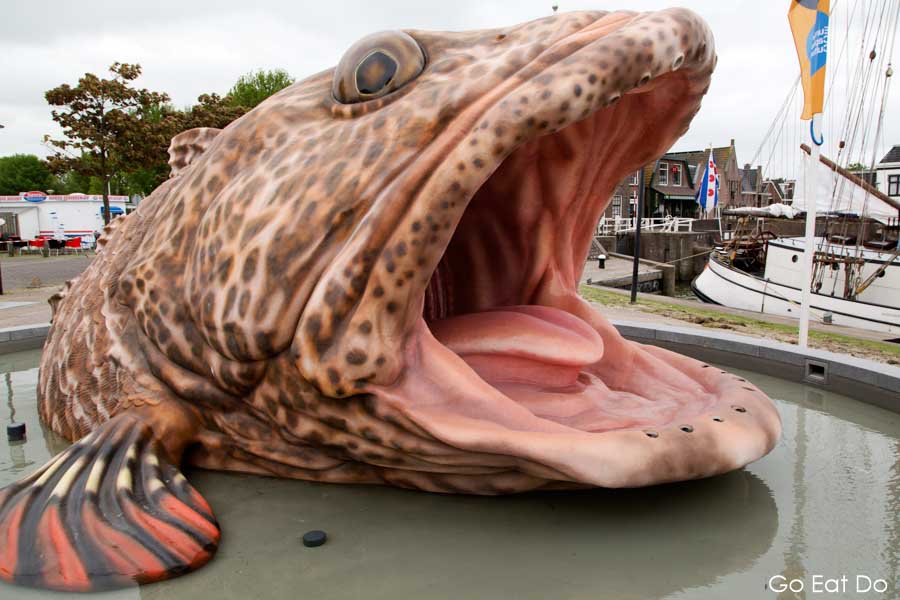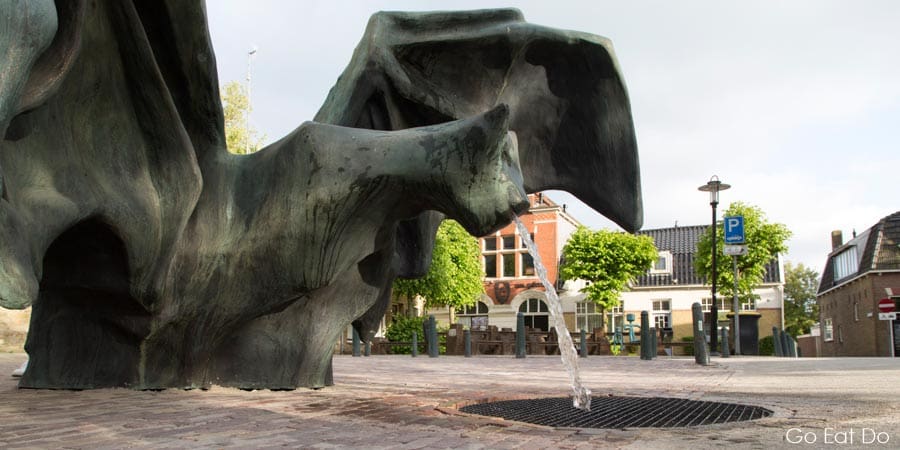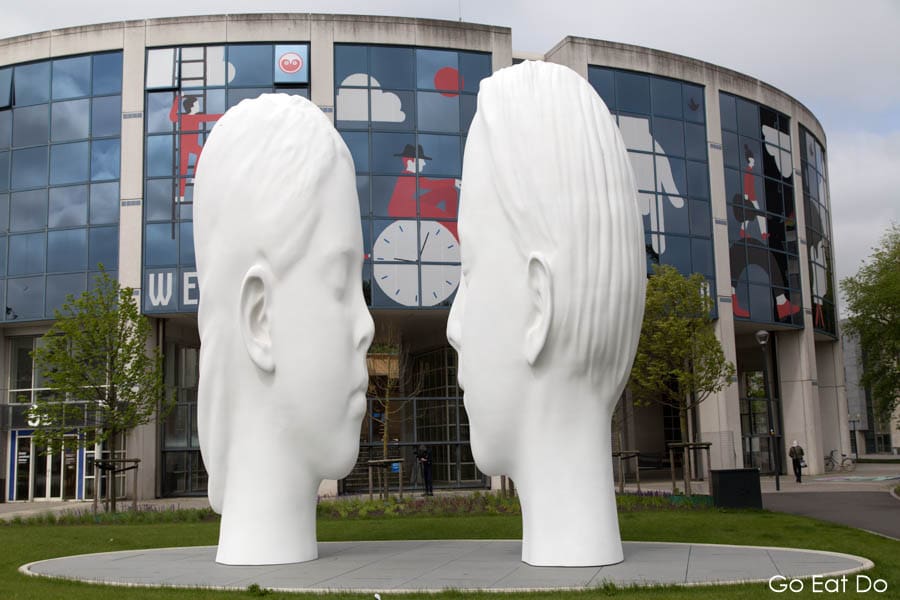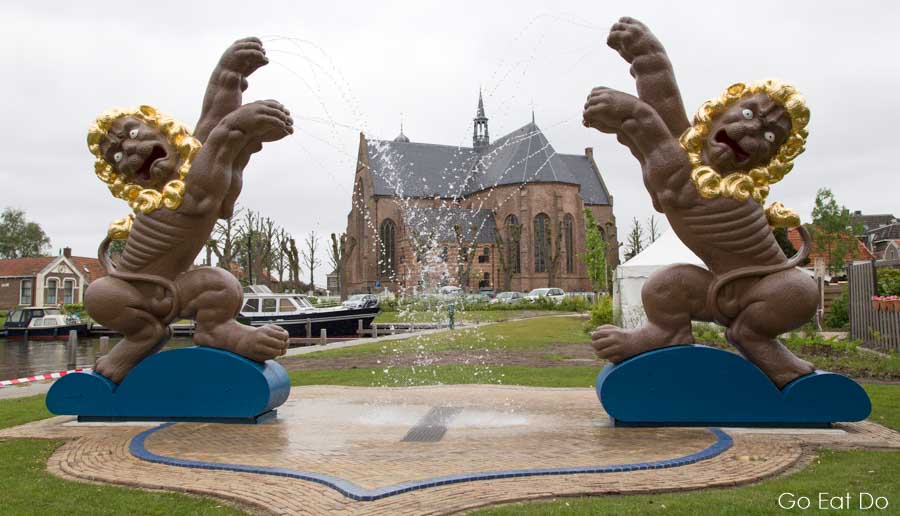“Can I climb on it?” asks a blond-haired boy excitedly, pointing at the bat fountain outside of the ruined Broerekerk, a Gothic church in the city of Bolsward, the Netherlands. The bronze sculpture, De Vleermuis, is designed by the Paris-based artist Johan Creten and is one of the 11 Fountains unveiled across Friesland as part of the 2018 European Capital of Culture programme.
Artist Johan Creten nods and looks pleased. Just a moment ago he was explaining how he wanted people to interact with his sculpture and snap selfies. The bronze bat has steps up its back, inviting visitors to climb onto its head and pose between the wings.
The young lad clambers onto the bat and his mother clicks a smartphone photo. After the boy runs back to his mother, Creten climbs onto his sculpture and poses for gathered journalists to take pictures. The shell of the medieval Broerekerk provides the backdrop. The interior of the church was destroyed by a fire in 1990. A glass roof has subsequently been added and the airy interior has become a popular venue for wedding photos in recent years.

European Capital of Culture 2018
The 11 fountains will remain after the European Capital of Culture moves on from Leeuwarden-Friesland. Waterways rather than roads were once the chief form of communication and transport between Friesland’s municipalities. The concept of water-based connections played a role in the inception of the 11 Fountains project.
There’s one fountain in each of the Frisian cities visited by ice-skaters participating in the 200-kilometre Elfstedentocht race. The event draws hundreds of thousands of spectators to the province. It was last held in 1997 as ice on canals must be at least 15 centimetres thick for the race to go ahead.
Anna Tilroe, the curator, initiated the 11 Fountains project. The top-down approach of inviting international rather than local artists plus the proposed costs for the construction and maintenance of the fountains drew criticism, prompting calls for greater community involvement. One notable reaction has been crowd-funding for a mobile fountain, designed by Henk de Boer, featuring a toilet and wooden penises. That work of protest will tour the province.
“From the very beginning, I worked very hard to get the people on board with the project by giving information and public presentations. This way fountains committees were born. They have been there all along: have chosen the location; met and informed the artists in all 11 cities. They have been a great support during the storm,” comments the curator.

The 11 Fountains project
The 11 commissioned fountains were unveiled officially on 18 May. Over the first couple of years of his involvement in the 11 Fountains project, which began in 2014, Creten came up with 10 different concepts for locations elsewhere in the Bolsward. Then the artist was shown what he describes as “this incredible location” by the Broerekerk.
“In the ecological system of Friesland bats are important,” says Creten explaining how he came up with his concept. “The Gothic building made me think of a bat. It’s something people are afraid of but in Asian culture it is seen as a bringer of luck. In Tarot the bat card is a story of resurrection.”

The site of De Vleermuis had long been utilised as a car park. During the installation of the fountain, which recycles water, 50 human skeletons were unearthed. Archaeologists have dated them to the Middle Ages and have concluded the location was previously a cemetery. Further excavations of the site are planned.
Creten explains how gargoyles, something he draws upon in his design, have a dark image yet were intended to scare away evil. Like a gargoyle on a medieval cathedral, water gushes from the mouth of his huge bronze bat, whose colour and surface texture is designed to look attractive even in rain.

1,500 kilograms of bronze
“It’s a sculpture that functions when there’s no water flowing. It stays a very touchable object,” says Creten while gently rubbing the nose of the 1,500-kilogram bronze. Engineers were among the team of 45 people who cooperated to enable water to flow via steelwork in the fountain’s interior.
“If you caress it, it will become golden,” says Creten of his bronze bat. “So it’s up to the people of Bolsward to turn it golden.”
In addition to the appearance of the fountain, the noise it makes is a factor in its design. The volume of the water, which is turned off at night, will rise and fall.
Fountains designed by Cornelia Parker, Jaume Plensa plus Lucy and Jorge Orta also count among those unveiled as part of the 11 Fountains project.

Further information
Find out more about the 11 Fountains project on the Friesland website.
See the Visit Friesland and Visit Holland websites to discover more about the region.
Stuart Forster, the author of this post, was named Journalist of the Year at the Holland Press Awards of 2015 and 2016. He can be commissioned to write features on the Netherlands.
Illustrating photographs are by Why Eye Photography. Why Eye Photography is available for food, travel and portrait photography commissions.
If you enjoyed this post why not sign up for the free Go Eat Do newsletter? It’s a hassle-free way of getting links to posts on a monthly basis.
‘Like’ the Go Eat Do Facebook page to see more photos and content.



